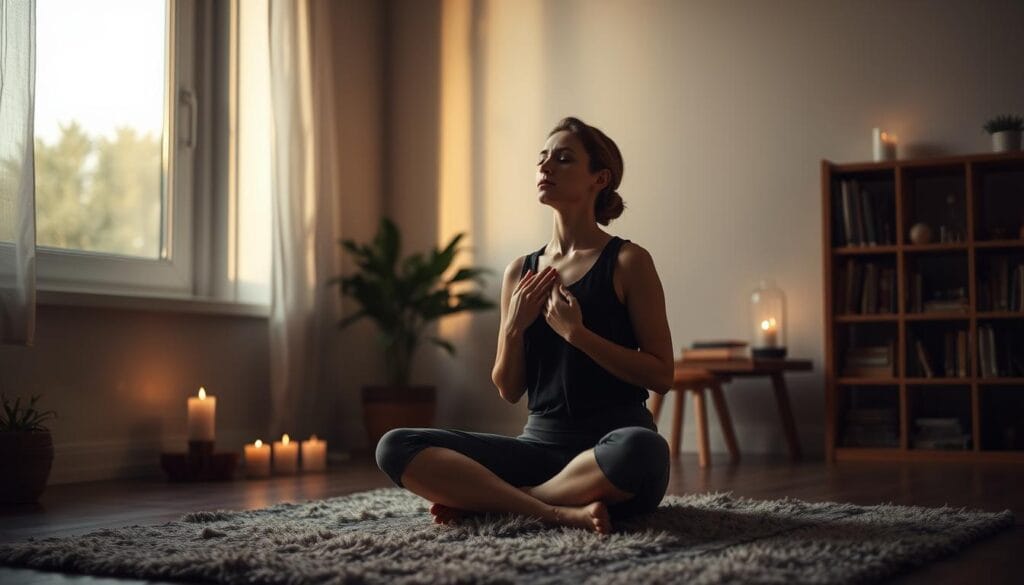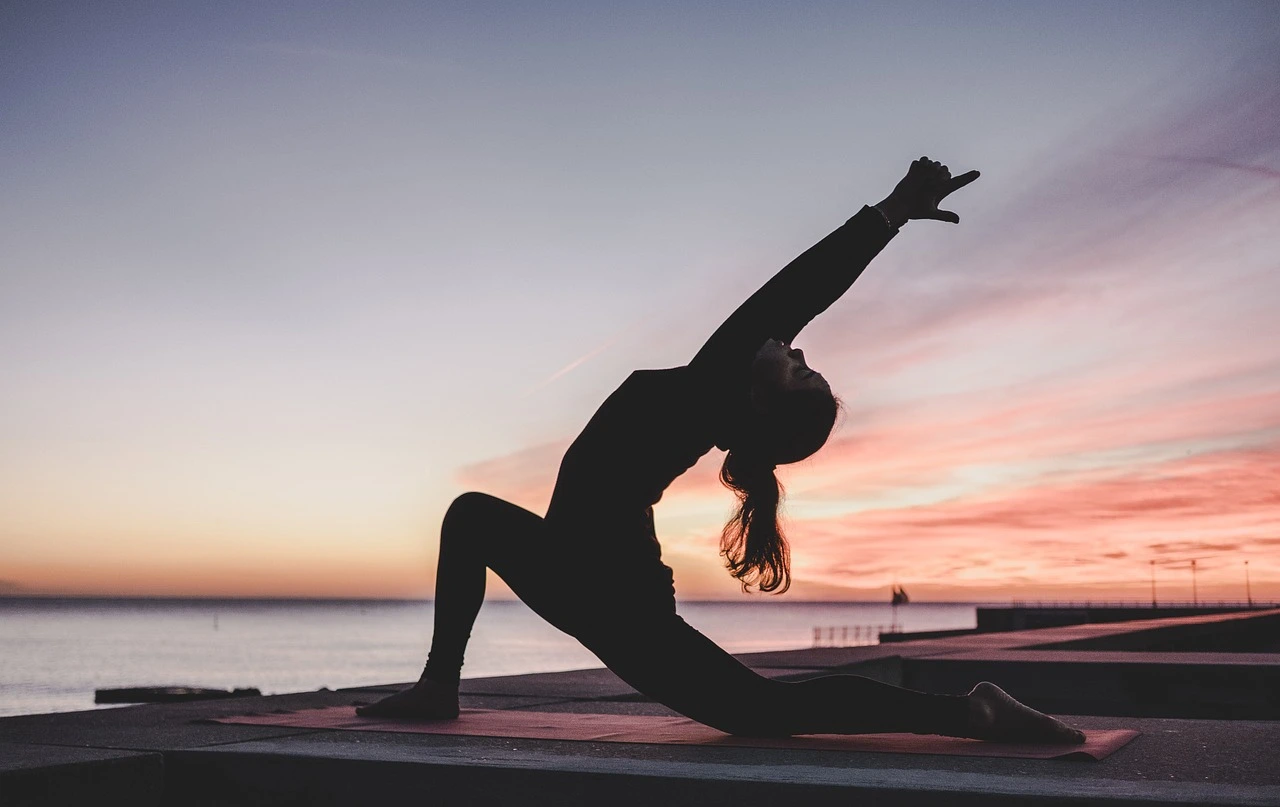Effective Breathing Exercises for Stress Relief and Relaxation
Stress used to weigh me down, making my thoughts race and my chest tight. But then I found breathing exercises for stress. Techniques like pursed lip breathing and diaphragmatic breathing brought me calm, even on busy days. These methods aren’t just fads; they’re supported by science.
Pursed lip breathing helps slow my breathing, easing tension. Diaphragmatic breathing teaches my body to breathe deeply, reducing strain.
Table of Contents
Understanding the Science of Breath

Every breath we take affects our health and mind. Let’s dive into how our bodies react to breathing.
How Breathing Impacts the Body
I started learning about breathing to reduce stress. I found out the diaphragm plays a big role in breathing. Shallow breathing limits oxygen, while deep breaths calm the nervous system.
| Breathing Pattern | Effect on Stress | Physiological Impact |
|---|---|---|
| Shallow Breathing | Increases tension | Rapid heart rate, reduced focus |
| Deep Breathing | Reduces anxiety | Stabilizes heart rate, improves blood flow |
The Connection Between Breath and Stress
Stress makes us breathe fast and raises cortisol levels. Studies show breathing exercises can change this. For instance, breathing slowly can improve heart rate variability (HRV), showing better resilience.
When I practiced slow breathing, my HRV went up. This helped me feel less stressed every day.

Identifying Stress Triggers Through Your Breath
I started by noticing how my breathing changed when I was stressed. Stress often makes my breath quick and shallow, not reaching deep into my lungs. These signs, like chest breathing or uneven breaths, warn me of stress.
By paying attention to these signs, I can act early to prevent stress from getting worse. Deep breathing exercises helped me understand these signals better.
When I feel my breath getting tight, I stop and take a moment. Do I breathe in fast through my mouth? Is my chest moving more than my belly? These signs tell me it’s time to calm down.
- Rapid breaths: A sign to slow down and focus on expanding my diaphragm.
- Shallow inhalations: A prompt to practice deeper, slower breaths to calm my nervous system.
- Irregular rhythms: A reminder to count breaths to restore balance.

By tracking my breath, I found out what triggers stress in me. For example, before deadlines, my breathing gets short. This is my cue to take a break and do some deep breathing exercises.
Over time, this habit of checking my breath became second nature. Now, even small changes in my breathing remind me to choose calm over stress. It’s all about being mindful, one breath at a time.
Breathing exercises for stress: Essential Techniques
Mindfulness breathing techniques can change how you deal with stress. They work best when done slowly and with focus. Here’s how to do them right:
Step-by-Step Instructions
Try these three proven exercises:
- Pursed Lip Breathing: Inhale quietly through your nose for 2 counts. Pucker lips and exhale twice as long through pursed lips. This helps release tension quickly.
- Diaphragmatic Breathing: Lie flat, place one hand on your chest and the other on your abdomen. Breathe in deeply so the lower hand rises more than the upper. Exhale fully, emptying the lungs.
- Breath Focus: Pair a calming word or phrase with each exhale. Repeat slowly, like whispering “calm” as you breathe out. This anchors your focus during stress.
Common Mistakes to Avoid
Avoid these pitfalls to maximize results:
- Hurried breathing: Take your time—rushing defeats the purpose.
- Overthinking steps: Trust your body’s rhythm; perfection isn’t required.
- Ignoring discomfort: If dizziness occurs, pause and restart gently.
| Technique | Key Steps | Primary Benefit |
|---|---|---|
| Pursed Lip | Nose inhale, prolonged exhale through pursed lips | Reduces breathlessness |
| Diaphragmatic | Engage belly muscles, not chest | Activates relaxation response |
| Breath Focus | Pair breath with a calming word | Improves mental clarity |
Practice these regularly to build resilience. Remember, consistency matters more than perfection. Small daily efforts make a big difference.
Integrating Mindfulness Breathing Techniques into Daily Life
Stress management techniques are most effective when they’re part of your daily routine. I’ve learned that being consistent is more important than being perfect. Even small moments of focusing on your breath can change how you handle busy days.
Simple Daily Practices
Begin with tiny moments. Here are some easy steps:
- In the morning: Take three deep breaths while brushing your teeth or making coffee.
- At work: Use a 60-second timer to pause and breathe deeply during screen breaks.
- Evenings: Combine breathwork with relaxing activities like stretching or journaling.
Mindful Moments That Make a Difference
Even brief pauses can be powerful. When a stressful email comes in, I take five deep breaths before answering. This simple habit helps break the stress cycle. Use your commute, waiting in line, or doing laundry as chances to stay present.
Research from 2023 in the Journal of Behavioral Medicine found that daily micro-practices can lower cortisol by up to 23%. Make these practices your own. Find what works for you, like a morning routine, a mid-day reset, or a bedtime ritual. Let your breath be your anchor, not a burden.
Mastering Deep Breathing Exercises for Relaxation
When I first learned relaxation techniques for anxiety, diaphragmatic breathing became my go-to tool. This method, also called belly breathing, shifts your body from stress mode to calm by engaging the diaphragm instead of shallow chest breaths.
Diaphragmatic Breathing Explained
Here’s how it works: Inhaling deeply through the nose expands the lungs fully, sending oxygen-rich air to the lower lungs. This triggers the vagus nerve, signaling the brain to slow heart rate and reduce cortisol. Research shows this activates the parasympathetic nervous system, your body’s natural “rest and digest” response.
Practical Tips for Deep Breathing
- Practice lying on your back with one hand on your chest and the other on your belly. The lower hand should rise more than the upper.
- Inhale for 4 counts, hold briefly, then exhale for 6 counts. Focus on the slow release of tension with each breath.
- Use guided apps like Calm or Headspace for structured sessions until it becomes second nature.
| Challenge | Solution |
|---|---|
| Difficulty feeling belly movement | Place a book on your stomach to track motion during practice |
| Short attention span | Start with 2-3 minute sessions, gradually increasing duration |
| Overbreathing | Purse lips slightly during exhales to regulate airflow |
After months of daily practice, I noticed reduced panic attacks and better focus. Consistency builds mastery—try 10 minutes daily in a quiet space. Your breath is a free, portable tool to combat anxiety anytime, anywhere.
Stress Relief Breathing Techniques: Real-World Applications
Many people find diaphragmatic breathing exercises to be life-changing. They help with daily challenges. For example, Sarah, a teacher, uses them to calm her nerves before class. Tech workers also practice them during lunch breaks.
These techniques aren’t just ideas. They actually work.
Personal Experiences and Success Stories
Studies from the American Institute of Stress show they reduce anxiety. I start my day with a few minutes of breathing. A nurse told me she breathes for 5 minutes during her shifts to stay focused.
These stories show the real impact of these exercises.
Adapting Techniques to Your Routine
Being adaptable is important. Here are some tips:
- Incorporate 3-5 minutes of diaphragmatic breathing exercises during commute or breaks
- Pair breathwork with morning coffee or before stressful tasks
- Use a 4-7-8 pattern (inhale 4 sec, hold 7 sec, exhale 8 sec) anytime
Small, consistent efforts lead to big changes. Start small—during a meeting, before a call, or while waiting in line. Every effort counts.
Crafting a Personalized Breathing Routine
Starting a breathing routine is about finding what works for you. breathing exercises for mental health vary from person to person. I try different methods like diaphragmatic breathing or mindful pauses to see what calms me.
I make these practices a part of my daily life. For example, I do them during my morning coffee or before bed. This helps me stay consistent.
I keep track of how I feel using a journal or app. This helps me see what works best. If a short session isn’t enough, I slowly increase the time.
- Pick 1-2 exercises that resonate most with your mood.
- Pair breathing practices with daily routines (e.g., while commuting or during lunch breaks).
- Review adjustments weekly to stay aligned with your mental health goals.
Being flexible is important. When work gets tough, I add more breaks. Small changes make breathing exercises for mental health a habit. The goal is to find what calms you, not to follow a strict plan.
Overcoming Challenges in Stress Management with Controlled Breathing
Starting with controlled breathing techniques can seem tough. Many, like Myosin Marketing team members, feel awkward or unsure at first. But, sticking with it can lead to big wins.
When I first tried these methods, I felt awkward too. It felt like doing something strange. But, as time went on, the benefits became clear.
Common challenges include not practicing regularly and doing it wrong. Here’s how to overcome these:
- Inconsistent practice: Use phone reminders or sticky notes to remember to breathe.
- Technique mistakes: Practice slow, deep breaths. If your shoulders go up, try lying down with a book on your stomach.
A table comparing pitfalls and solutions:
| Pitfall | Solution |
|---|---|
| Feeling distracted | Pair breathing with routine tasks like washing dishes |
| Quickly losing motivation | Track progress in a journal or app |
Try different methods to find what works for you. If 4-7-8 feels too fast, try box breathing. Listen to your body—if you feel dizzy, make sessions shorter. Even a minute a day can help you manage stress better over time.
Enhancing Mental Health with Mindful Breathing Exercises
Studies prove that mindful breathing exercises can greatly improve mental health. By focusing on breathing, people can relax naturally. This helps reduce anxiety and brings calmness.
These exercises also lower stress hormones. They help calm the mind and reduce symptoms of anxiety and depression.
Psychological Benefits of Focused Breathing
Regular mindful breathing exercises make us emotionally stronger. Here’s how:
- Slows racing thoughts, reducing overwhelm
- Boosts focus and mental clarity
- Encourages self-awareness and emotional balance
Incorporating Breathing into Mental Health Practices
Start small. Try these steps:
- Pair mindful breathing exercises with morning routines to set a calm tone for the day
- Use 5-minute sessions before stressful tasks to reset focus
- Combine with journaling or yoga for deeper impact
Therapists often suggest these techniques. Even short, regular practice can help improve mood and coping skills over time.
Conclusion
Breathing exercises are a great way to handle stress and find peace. I’ve seen how even short daily practices can change things. Techniques like mindful breathing or deep breathing can really help.
Being consistent is key. Try out different methods to see what works for you. It might take time, but every little bit counts. Making breathwork a regular part of your life is more than just calming your mind. It’s about taking care of your mental health.
Be patient and keep at it. Your breath is always with you. Use it to find calm in a busy world.
FAQ
What are breathing exercises for stress relief?
Breathing exercises for stress relief help you focus on your breath. They promote relaxation and reduce anxiety. Techniques include pursed lip breathing and diaphragmatic breathing. These exercises improve your mental health.
How can I incorporate mindfulness breathing techniques into my daily routine?
To add mindfulness breathing to your day, set aside short breaks. Use these moments for focused breathing. Deep breathing exercises can refresh your mind and body. They help you stay calm and relieve stress.
What is diaphragmatic breathing, and why is it important?
Diaphragmatic breathing, or deep breathing, uses your diaphragm fully. It maximizes oxygen intake. This type of breathing is key for calming stress responses and promoting relaxation.
What are some common mistakes to avoid when practicing breathing exercises?
Don’t hold your breath or breathe too quickly. Make sure to use your diaphragm effectively. Stay patient and practice often to avoid these mistakes and get the most from your exercises.
Can breathing exercises really help with anxiety management?
Yes, breathing exercises can help manage anxiety. Mindful breathing can calm your mind and improve your focus. It’s a valuable tool for anxiety relief.
How can I track my progress with breathing exercises?
Keep a journal of your breathing practice. Note the techniques, duration, and your emotional state before and after. This helps you see what works best and stay consistent.
How often should I practice breathing techniques for stress management?
Practicing breathing techniques daily, even for a few minutes, is beneficial. Use them during stressful moments. This reinforces your skills and boosts their effectiveness over time.
What are some effective breathing techniques for quick stress relief?
For quick stress relief, try pursed lip breathing. Breathe in through your nose and out through pursed lips. Simple deep breathing exercises also work well. They focus on inhaling deeply through your diaphragm to relax.
Source Links
- https://www.verywellmind.com/how-to-reduce-stress-with-breathing-exercises-3144508
- https://www.clevelandclinic.org/health/treatments/9443-pursed-lip-breathing
- https://www.healthline.com/health/copd/pursed-lip-breathing
- https://www.apnews.com/article/8c0636a09d605ef0c56e529e8be0f2f9
- https://time.com/7097021/copd-exercise-recommendations/
- https://apnews.com/article/8c0636a09d605ef0c56e529e8be0f2f9
- https://www.heart.org/en/healthy-living/healthy-lifestyle/stress-management
- https://health.osu.edu/wellness/integrative-healing/how-breathing-exercises-can-calm-anxiety-effectively

